
94% of researchers rate our articles as excellent or good
Learn more about the work of our research integrity team to safeguard the quality of each article we publish.
Find out more
ORIGINAL RESEARCH article
Front. Chem. , 29 June 2021
Sec. Supramolecular Chemistry
Volume 9 - 2021 | https://doi.org/10.3389/fchem.2021.710808
This article is part of the Research Topic Suprastars of Chemistry View all 14 articles
Fullerene has attracted much attention in biomedical research due to its unique physical and chemical properties. However, the hydrophobic nature of fullerene is limited to deploy in the body, given that the biofluids are mainly water. In this study, a water-soluble supramolecular nanoformulation based on a deep cavitand calixarene (SAC4A) and fullerene is developed to overcome the hydrophobicity of fullerene and is used as a potential photodynamic agent. SAC4A solubilizes fullerene very well with a simple grinding method. The significantly increased water solubility of fullerene enables efficient activation of reactive oxygen species. The host–guest strategy to solubilize fullerene can not only provide a new method to achieve water solubility but also expand the biomedical applications of fullerene.
Fullerene has been widely used in biomedical research, acting as an antimicrobial agent (Mashino et al., 1999; Tsao et al., 2001), a human immunodeficiency virus protease inhibitor (Friedman et al., 1993), and a photosensitizer to cleave DNA (Boutorine et al., 1995; Sharma et al., 2011). It can efficiently form long-lived triplet excited states by visible-light irradiation and generate highly reactive oxygen species (ROS) via an electron transfer Type I reaction, which generates superoxide anions (O2−•) yielding hydroxyl radicals, and/or an energy transfer Type II reaction, which generates singlet oxygen molecules (1O2) (Yamakoshi et al., 2003). However, the hydrophobicity of fullerene limits its potential applications as photosensitizer in biological fluids. Much effort has been focused on increasing fullerene water solubility by grafting hydrophilic groups on fullerene (Rašović, 2016). Nevertheless, chemical modifications usually lead to the unanticipated alternation of fullerene photophysical properties (Hamano et al., 1997; Prat et al., 1999). Therefore, the solubilization of fullerene in a non-covalent approach emerges to be an alternative approach (Zhang et al., 2014). Macrocyclic hosts have been engaged in solubilizing fullerene in water [e.g., cyclodextrins (CD) and calixarenes] (Ikeda, 2013). Braun et al. investigated the solid–solid mechanochemical reaction between fullerene and γ-CD by ball-milling their mixture. The concentration of C60 in water was 1.5 × 10–4 M [(γ-CD) = 6.5 × 10–3 M] (Braun et al., 1994). Komatsu et al. examined that the equimolar amounts of C60 and sulfonatocalix[8]arene were subjected to high-speed vibration milling treatment, and the concentration of C60 was calculated to be 1.3 × 10–4 M (Komatsu et al., 1999). These water-soluble fullerenes solubilized by macrocycles confirm the feasibility of the host–guest strategy. Moreover, the complexation of fullerenes by macrocycles is an important way used to improve their photoactivities (Antoku et al., 2019).
In this work, we synthesized sulfonated azocalix[4]arene (SAC4A), which possesses a deep cavity that imparts strong binding to hydrophobic cargoes. Additionally, the -SO3− functional groups endow calixarene with water solubility and also provide anchoring points that supplement the cavity binding to guests (Guo et al., 2014; Pan et al., 2017; Pan et al., 2021; Pan et al., 2021). As expected, SAC4A solubilized fullerene under the condition of a molar ratio of 1:1 by the grinding method (Figure 1), which is a simpler method than ball-milling or high-speed vibration milling treatment. We further evaluated its ability to generate ROS under LED irradiation, which is significant on account of its further biomedical applications.
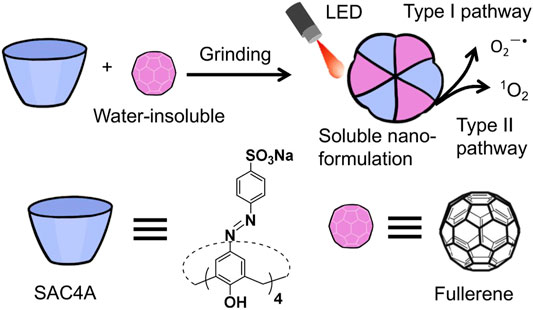
FIGURE 1. Schematic illustration of supramolecular nanoformulation formed by the host–guest complexation between SAC4A and fullerene. The encapsulation of fullerene with SAC4A gives rise to improved solubility and efficiently activated ROS.
Calixarene was employed as the macrocyclic host because of its broad chemical design space (Böhmer, 1995). By making calix[4]arene to directly react with 4-sulfobenzenediazonium chloride, SAC4A was obtained with a high yield (Figure 2A and Supplementary Figure S1) (Lu et al., 2005). Sulfocalix[n]arenes (SCnAs, n = 4, 5, and 6) without deep cavity were synthesized as controls (Figure 2A), referring to literatures (Shinkai et al., 1987; Steed et al., 1995). The calixarene-solubilized fullerenes (C60 and C70) were prepared by the grinding method (for more details, see the Supplementary Material). The concentrations of C60 and C70 in the supernatant were determined by high-performance liquid chromatography (Figure 2B). The concentration of C60 by supramolecular complexation with SAC4A increased to 6.45 × 10–4 M. The solubilization effect of SAC4A is significantly higher than that of the control of SCnAs. It may be observed that the cavity of SC4A is too small to accommodate fullerene. Even if adding repetitive units to expand the cavity latitudinally, the cavities of SC5A and SC6A are still too shallow to encapsulate fullerene. On the other hand, the azobenzene modification endows SAC4A with a deep cavity that is suitable to include hydrophobic guests (Zhang et al., 2020). It is suggested that calixarene is more effective in solubilizing fullerene by extending the cavity longitudinally than latitudinally.
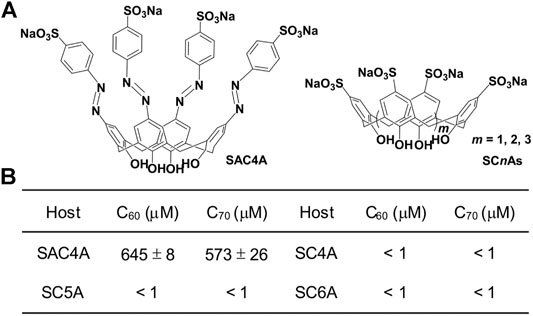
FIGURE 2. (A) Molecular structures of SAC4A and SCnAs. (B) The concentrations of C60 and C70 solubilized by calixarenes (1 mM for hosts).
Due to the best solubilizing effect, we selected the C60@SAC4A system to representatively study its size and morphology. Dynamic light scattering (DLS) was employed to identify the size of the C60@SAC4A assembly (Guo et al., 2020), giving a hydration diameter of 28 nm with a polydispersity index (PDI) of 0.135 (Figure 3A). The representative transmission electron microscopy (TEM) image (Li et al., 2020) revealed that the C60@SAC4A assembly possessed a spherical morphology with an average size of 20 nm (Figure 3B), which was smaller than the DLS result due to the dehydration that occurred during the TEM sample preparation (Yang et al., 2020). C60@SAC4A forms water-soluble nanoformulation rather than simple host–guest complex, implying a potential passive targeting ability through enhanced permeation and retention (EPR) effect when used in vivo (Gao et al., 2018; Cai et al., 2021).
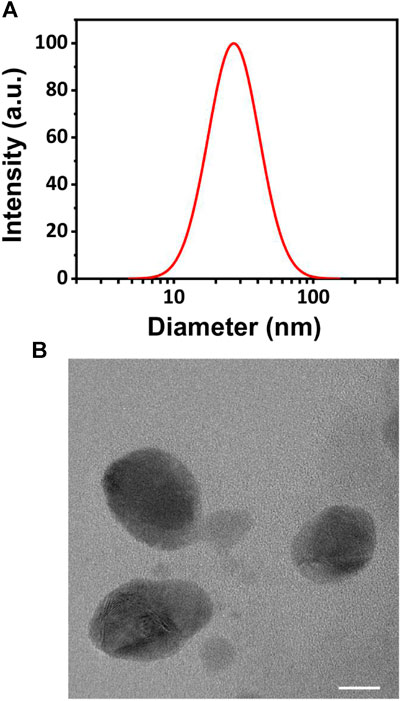
FIGURE 3. (A) The DLS data of the C60@SAC4A assembly in PBS buffer (10 mM, pH = 7.4), at 25°C. (B) TEM image of the C60@SAC4A assembly (scale bar, 10 nm).
The stability of assembly is a fundamental factor. A DLS test was performed to observe the particle size changes of C60@SAC4A at different time points (Supplementary Figure S2). The C60@SAC4A assembly shows no significant changes in particle size within 7 days. These results proved that the C60@SAC4A assembly is stable in time. SAC4A is expected to be a supramolecular solubilizing agent to disperse fullerene in water.
The identification and research of ROS are crucial for the further development of photodynamic therapy based on fullerenes as photosensitizers. In order to see if it was a potential photodynamic agent, the ROS generation capacities of C60@SAC4A were investigated by a commercial indicator, 2,7-dichlorodihydrofluorescein (DCFH), that responds to general types of ROS (Zhuang et al., 2020). Upon exposure to LED irradiation, the nonemissive DCFH solution with C60@SAC4A exhibits increased fluorescence intensity, accomplishing approximately 35-fold enhancement within 1 min, while those of control groups under the same conditions are barely increased (Figure 4A). Additionally, γ-cyclodextrin–solubilized C60 (C60@γ-CD) was chosen as the positive control group, showing a little fluorescence increase under LED irradiation, due to the reactivity of C60 with O2 decreased when it was enclosed in the γ-CD cavity (Priyadarsini et al., 1994). Another possible reason is that the amount of cyclodextrin used for solubilization is much higher than that of calixarene, resulting that the cyclodextrin limits the contact between C60 and O2. Figure 4B showed the fluorescence response of DCFH to ROS treated with C60@SAC4A of different concentrations, suggesting that the peak intensity and the concentration of C60@SAC4A were increased in a concentration-dependent manner.
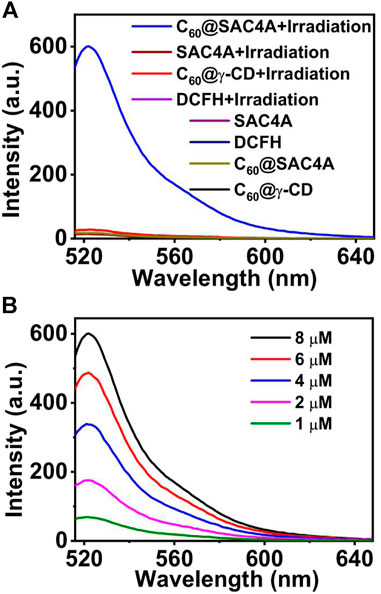
FIGURE 4. (A) Fluorescence response of DCFH to ROS treated with C60@SAC4A (8 μM for C60), SAC4A (10 μM), and C60@γ-CD (8 μM for C60) under LED irradiation for 1 min or no irradiation. (B) Fluorescence response of DCFH to ROS treated with C60@SAC4A of different concentrations under LED irradiation for 1 min.
Electron paramagnetic resonance (EPR) spectroscopy is one powerful method to identify short-lived ROS species (Zang et al., 1998). 5,5-Dimethyl-1-pyrroline-N-oxide (DMPO) was used as a spin-trap agent to detect O2−•. Figure 5A shows the spectra obtained for DMPO/O2−• adduct, indicative of the generation of O2−• from C60@SAC4A under light and nicotinamide adenine dinucleotide (reduced, NADH, to mimic the strong reducing environment) conditions, namely, Type I ROS (Zhao et al., 2008). In the absence of either NADH or C60, there were no appreciable O2−• signals detected (Supplementary Figure S3A), showing that electron transfer processes induced by reducing agents are very significant for the generation of O2−• in aqueous systems (Yamakoshi et al., 2003). For the detection of 1O2, the EPR method with 2,2,6,6-tetramethyl-4-piperidone (TEMP) was employed. As shown in Figure 5B, the resultant EPR spectra displayed a typical 1:1:1 triplet signal, which is the characteristic resonance for TEMP/1O2 adduct, whereas no signal was detected in the control group containing SAC4A under the same condition (Supplementary Figure S3B), indicative of its good ability of Type II ROS (Yamakoshi et al., 2003). Based on the above evidence, it is consequently reasonable to draw a conclusion that C60@SAC4A followed both Type I and Type II pathways to generate ROS species, indicating that C60@SAC4A can be a promising candidate as a water-soluble supramolecular photosensitizer.
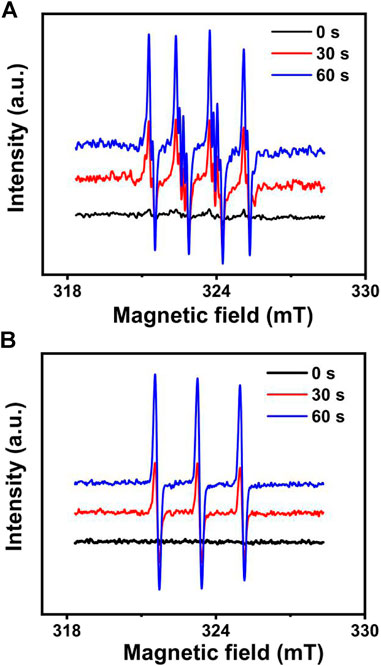
FIGURE 5. (A) EPR signals of DMPO (for Type I ROS detection) in the presence of C60@SAC4A (80 μM for C60) with NADH (5 mM) irradiated for 0, 30, or 60 s. (B) EPR signals of TEMP (for Type II ROS detection) in the presence of C60@SAC4A (80 μM for C60) irradiated for 0, 30, or 60 s.
In summary, SAC4A was synthesized and used to improve the water solubility of fullerene by host–guest complexation. Compared with SCnAs that are widely studied as classical water-soluble calixarene derivatives, SAC4A possesses the deeper cavity longitudinally and is more effective in solubilizing fullerene. The supramolecular nanoformulation C60@SAC4A generates ROS species effectively in both Type I and Type II pathways, indicative of a potential photodynamic agent. Calixarene is highly modifiable, and thus, a lot of water-soluble derivatives could be obtained to solubilize hydrophobic substances besides fullerenes. One important lesson from this work is that vertical expansion of cavity emerges to be a more powerful way than horizontal expansion to solubilize large hydrophobic species on account of the cone shape of calixarene.
The original contributions presented in the study are included in the article/Supplementary Material; further inquiries can be directed to the corresponding authors.
H-BL and D-SG conceived the experiments. T-XZ and J-JL conducted the experiments. T-XZ, H-BL, and D-SG contributed to writing of the manuscript with input from the other authors.
Financial support was obtained from the NSFC (U20A20259 and 31961143004), the Fundamental Research Funds for the Central Universities, and NCC Fund (NCC2020FH04), which are gratefully acknowledged.
The authors declare that the research was conducted in the absence of any commercial or financial relationships that could be construed as a potential conflict of interest.
The Supplementary Material for this article can be found online at: https://www.frontiersin.org/articles/10.3389/fchem.2021.710808/full#supplementary-material
Antoku, D., Sugikawa, K., and Ikeda, A. (2019). Photodynamic Activity of Fullerene Derivatives Solubilized in Water by Natural‐Product‐Based Solubilizing Agents. Chem. Eur. J. 25, 1854–1865. doi:10.1002/chem.201803657
Böhmer, V. (1995). Calixarenes, Macrocycles with(Almost) Unlimited Possibilities. Angew. Chem. Int. Ed. Engl. 34, 713–745. doi:10.1002/anie.199507131
Boutorine, A. S., Takasugi, M., Hélène, C., Tokuyama, H., Isobe, H., and Nakamura, E. (1995). Fullerene-Oligonucleotide Conjugates: Photoinduced Sequence-specific DNA Cleavage. Angew. Chem. Int. Ed. Engl. 33, 2462–2465. doi:10.1002/anie.199424621
Braun, T., Buvaribarcza, A., Barcza, L., Konkolythege, I., Fodor, M., and Migali, B. (1994). Mechanochemistry: a Novel Approach to the Synthesis of Fullerene Compounds. Water Soluble Buckminsterfullerene - γ-cyclodextrin Inclusion Complexes via a Solid-Solid Reaction. Solid State Ionics 74, 47–51. doi:10.1016/0167-2738(94)90435-9
Cai, Y., Zhang, Z., Ding, Y., Hu, L., Wang, J., Chen, T., et al. (2021). Recent Development of Pillar[n]arene-Based Amphiphiles. Chin. Chem. Lett. 32, 1267–1279. doi:10.1016/j.cclet.2020.10.036
Friedman, S. H., DeCamp, D. L., Sijbesma, R. P., Srdanov, G., Wudl, F., and Kenyon, G. L. (1993). Inhibition of the HIV-1 Protease by Fullerene Derivatives: Model Building Studies and Experimental Verification. J. Am. Chem. Soc. 115, 6506–6509. doi:10.1021/ja00068a005
Gao, J., Li, J., Geng, W.-C., Chen, F.-Y., Duan, X., Zheng, Z., et al. (2018). Biomarker Displacement Activation: a General Host-Guest Strategy for Targeted Phototheranostics In Vivo. J. Am. Chem. Soc. 140, 4945–4953. doi:10.1021/jacs.8b02331
Guo, D.-S., and Liu, Y. (2014). Supramolecular Chemistry of P-Sulfonatocalix[n]arenes and its Biological Applications. Acc. Chem. Res. 47, 1925–1934. doi:10.1021/ar500009g
Guo, H., Yan, X., Lu, B., Wang, J., Yuan, X., Han, Y., et al. (2020). Pillar[5]arene-based Supramolecular Assemblies with Two-step Sequential Fluorescence Enhancement for Mitochondria-Targeted Cell Imaging. J. Mater. Chem. C 8, 15622–15625. doi:10.1039/d0tc04343e
Hamano, T., Okuda, K., Mashino, T., Hirobe, M., Arakane, K., Ryu, A., et al. (1997). Singlet Oxygen Production from Fullerene Derivatives: Effect of Sequential Functionalization of the Fullerene Core. Chem. Commun., 21–22. doi:10.1039/a606335g
Ikeda, A. (2013). Water-soluble Fullerenes Using Solubilizing Agents, and Their Applications. J. Incl Phenom Macrocycl Chem. 77, 49–65. doi:10.1007/s10847-013-0319-9
Komatsu, K., Fujiwara, K., Murata, Y., and Braun, T. (1999). Aqueous Solubilization of Crystalline Fullerenes by Supramolecular Complexation with γ-cyclodextrin and Sulfocalix[8]arene under Mechanochemical High-Speed Vibration Milling. J. Chem. Soc. Perkin Trans. 1 1, 2963–2966. doi:10.1039/A904736K
Li, L., Tuo, W., Zhu, Q., Sepehrpour, H., Yao, Y., Yan, C., et al. (2020). Resorcinarene Induced Assembly of Carotene and Lutein into Hierarchical Superstructures. J. Am. Chem. Soc. 142, 20583–20587. doi:10.1021/jacs.0c10901
Lu, L., Zhu, S., Liu, X., Xie, Z., and Yan, X. (2005). Highly Selective Chromogenic Ionophores for the Recognition of Chromium(III) Based on a Water-Soluble Azocalixarene Derivative. Analytica Chim. Acta 535, 183–187. doi:10.1016/j.aca.2004.11.059
Mashino, T., Okuda, K., Hirota, T., Hirobe, M., Nagano, T., and Mochizuki, M. (1999). Inhibition ofE. Coli Growth by Fullerene Derivatives and Inhibition Mechanism. Bioorg. Med. Chem. Lett. 9, 2959–2962. doi:10.1016/S0960-894X(99)00515-6
Pan, Y.-C., Tian, H.-W., Peng, S., Hu, X.-Y., and Guo, D.-S. (2017). Molecular Recognition of Sulfonatocalixarene with Organic Cations at the Self-Assembled Interface: a Thermodynamic Investigation. Chin. Chem. Lett. 28, 787–792. doi:10.1016/j.cclet.2016.12.027
Pan, Y. C., Barba‐Bon, A., Tian, H. W., Ding, F., Hennig, A., Nau, W. M., et al. (2021). An Amphiphilic Sulfonatocalix[5]arene as an Activator for Membrane Transport of Lysine‐rich Peptides and Proteins. Angew. Chem. Int. Ed. 60, 1875–1882. doi:10.1002/anie.202011185
Pan, Y. C., Hu, X. Y., and Guo, D. S. (2021). Biomedical Applications of Calixarenes: State of the Art and Perspectives. Angew. Chem. Int. Ed. 60, 2768–2794. doi:10.1002/anie.201916380
Prat, F., Stackow, R., Bernstein, R., Qian, W., Rubin, Y., and Foote, C. S. (1999). Triplet-state Properties and Singlet Oxygen Generation in a Homologous Series of Functionalized Fullerene Derivatives. J. Phys. Chem. A. 103, 7230–7235. doi:10.1021/jp991237o
Priyadarsini, K. I., Mohan, H., Tyagi, A. K., and Mittal, J. P. (1994). Inclusion Complex of .gamma.-Cyclodextrin-C60: Formation, Characterization, and Photophysical Properties in Aqueous Solutions. J. Phys. Chem. 98, 4756–4759. doi:10.1021/j100068a044
Rašović, I. (2016). Water-soluble Fullerenes for Medical Applications. Mater. Sci. Techn. 33, 777–794. doi:10.1080/02670836.2016.1198114
Sharma, S. K., Chiang, L. Y., and Hamblin, M. R. (2011). Photodynamic Therapy with Fullerenesin Vivo: Reality or a Dream? Nanomedicine 6, 1813–1825. doi:10.2217/NNM.11.144
Shinkai, S., Araki, K., Tsubaki, T., Arimura, T., and Manabe, O. (1987). New Syntheses of Calixarene-P-Sulphonates and P-Nitrocalixarenes. J. Chem. Soc. Perkin Trans. 1 1, 2297–2299. doi:10.1039/P19870002297
Steed, J. W., Johnson, C. P., Barnes, C. L., Juneja, R. K., Atwood, J. L., Reilly, S., et al. (1995). Supramolecular Chemistry of P-Sulfonatocalix[5]arene: a Water-Soluble, Bowl-Shaped Host with a Large Molecular Cavity. J. Am. Chem. Soc. 117, 11426–11433. doi:10.1021/ja00151a006
Tsao, N., Luh, T.-Y., Chou, C.-K., Wu, J.-J., Lin, Y.-S., and Lei, H.-Y. (2001). Inhibition of Group a streptococcus Infection by Carboxyfullerene. Antimicrob. Agents Chemother. 45, 1788–1793. doi:10.1128/aac.45.6.1788-1793.2001
Yamakoshi, Y., Umezawa, N., Ryu, A., Arakane, K., Miyata, N., Goda, Y., et al. (2003). Active Oxygen Species Generated from Photoexcited Fullerene (C60) as Potential Medicines: O2-versus1O2. J. Am. Chem. Soc. 125, 12803–12809. doi:10.1021/ja0355574
Yang, L., Zhang, C., Liu, J., Huang, F., Zhang, Y., Liang, X. J., et al. (2020). ICG‐Conjugated and 125 I‐Labeled Polymeric Micelles with High Biosafety for Multimodality Imaging‐Guided Photothermal Therapy of Tumors. Adv. Healthc. Mater. 9, 1901616. doi:10.1002/adhm.201901616
Zang, L.-Y., Cosma, G., Gardner, H., and Vallyathan, V. (1998). Scavenging of Reactive Oxygen Species by Melatonin. Biochim. Biophys. Acta (Bba) - Gen. Subjects 1425, 469–477. doi:10.1016/s0304-4165(98)00099-3
Zhang, T. X., Zhang, Z. Z., Yue, Y. X., Hu, X. Y., Huang, F., Shi, L., et al. (2020). A General Hypoxia‐Responsive Molecular Container for Tumor‐Targeted Therapy. Adv. Mater. 32, 1908435. doi:10.1002/adma.201908435
Zhang, W., Gong, X., Liu, C., Piao, Y., Sun, Y., and Diao, G. (2014). Water-soluble Inclusion Complex of Fullerene with γ-cyclodextrin Polymer for Photodynamic Therapy. J. Mater. Chem. B 2, 5107–5115. doi:10.1039/c4tb00560k
Zhao, B., Bilski, P. J., He, Y.-Y., Feng, L., and Chignell, C. F. (2008). Photo-induced Reactive Oxygen Species Generation by Different Water-Soluble Fullerenes (C60) and Their Cytotoxicity in Human Keratinocytes. Photochem. Photobiol. 84, 1215–1223. doi:10.1111/j.1751-1097.2008.00333.x
Keywords: supramolecular chemistry, photodynamic agent, calixarene, fullerene, solubility
Citation: Zhang T-X, Li J-J, Li H-B and Guo D-S (2021) Deep Cavitand Calixarene–Solubilized Fullerene as a Potential Photodynamic Agent. Front. Chem. 9:710808. doi: 10.3389/fchem.2021.710808
Received: 17 May 2021; Accepted: 09 June 2021;
Published: 29 June 2021.
Edited by:
Tangxin Xiao, Changzhou University, ChinaReviewed by:
Yong Yao, Nantong University, ChinaCopyright © 2021 Zhang, Li, Li and Guo. This is an open-access article distributed under the terms of the Creative Commons Attribution License (CC BY). The use, distribution or reproduction in other forums is permitted, provided the original author(s) and the copyright owner(s) are credited and that the original publication in this journal is cited, in accordance with accepted academic practice. No use, distribution or reproduction is permitted which does not comply with these terms.
*Correspondence: Hua-Bin Li, bGlodWFiaW5AbmFua2FpLmVkdS5jbg==; Dong-Sheng Guo, ZHNoZ3VvQG5hbmthaS5lZHUuY24=
†These authors have contributed equally to this work and share first authorship
Disclaimer: All claims expressed in this article are solely those of the authors and do not necessarily represent those of their affiliated organizations, or those of the publisher, the editors and the reviewers. Any product that may be evaluated in this article or claim that may be made by its manufacturer is not guaranteed or endorsed by the publisher.
Research integrity at Frontiers

Learn more about the work of our research integrity team to safeguard the quality of each article we publish.